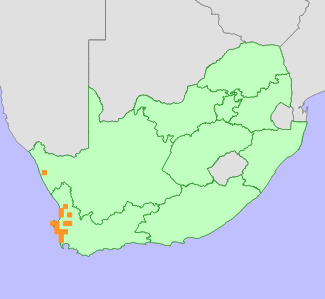|
Scientific Name | Lessertia meyeri Boatwr.T.Nkonki & B.-E.van Wyk |
Higher Classification | Dicotyledons |
Family | FABACEAE |
National Status |
Status and Criteria | Least Concern |
Assessment Date | 2014/05/14 |
Assessor(s) | J.S. Boatwright, T. Nkonki & D. Raimondo |
Justification | A widespread (EOO 21 416 km²), and still relatively common species in spite of extensive habitat loss in the southern part of its range. It is not yet considered in danger of extinction, but continues to decline. |
Distribution |
Endemism | South African endemic |
Provincial distribution | Northern Cape, Western Cape |
Range | Namaqualand to the Cape Peninsula, with a disjunct record from near Montagu. |
Habitat and Ecology |
Major system | Terrestrial |
Major habitats | Fynbos, Succulent Karoo |
Description | Sandy or rocky granite, limestone or tillite soils in strandveld, lowland sand fynbos and sandstone fynbos. |
Threats |
| Threatened by ongoing habitat loss and fragmentation due to crop cultivation, coastal development, urban expansion and competition from alien invasive plants, predominantly in the southern part of its range, where at least 25% of its habitat is now irreversibly modified. Subpopulations further north are not severely threatened. |
Population |
This species has been most commonly recorded on the Western Cape's western coastal lowlands, where many subpopulations known through historical records are now locally extinct due to habitat loss and degradation. It is known from only a few, scattered records further north into Namaqualand, but it is not certain whether this is a true reflection of the abundance of this species, as this are remains botanically less well explored than the southern part of this species' range. It is estimated, based on habitat loss, that the southern portion of the population has been reduced by as much as 25%, but it is difficult to estimate the total population reduction. In spite of extensive habitat loss, this species is however still considered common, remaining at at least 20 locations, but it continues to decline.
|
Population trend | Decreasing |
Assessment History |
Taxon assessed |
Status and Criteria |
Citation/Red List version | | Lessertia meyeri Boatwr.T.Nkonki & B.-E.van Wyk | Least Concern | 2014.1 | |
Bibliography |
Boatwright, J.S., Nkonki, T. and Van Wyk, B.-E. 2011. The identity of Lessertia rigida (Thunb.) DC. (Galegeae, Fabaceae) and a new species from the Greater Cape Region of South Africa. Systematic Botany 36(2):371-375.
|
Citation |
| Boatwright, J.S., Nkonki, T. & Raimondo, D. 2014. Lessertia meyeri Boatwr.T.Nkonki & B.-E.van Wyk. National Assessment: Red List of South African Plants version 2024.1. Accessed on 2025/11/21 |
 Comment on this assessment
Comment on this assessment


